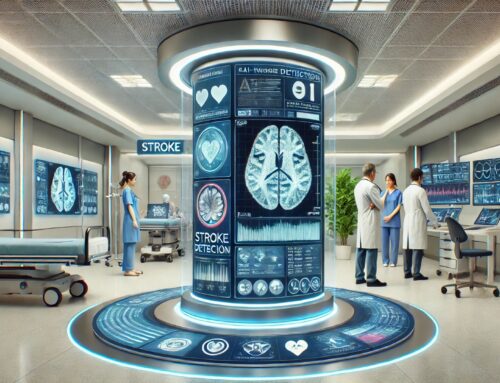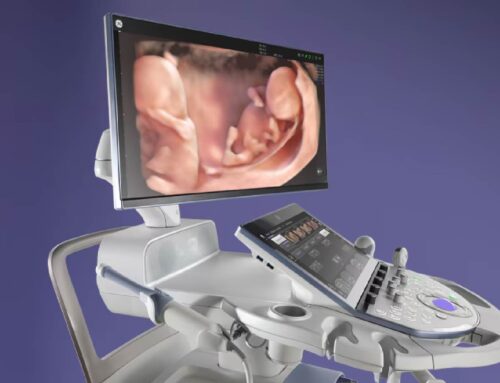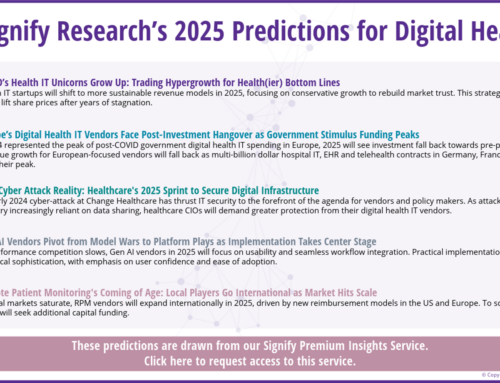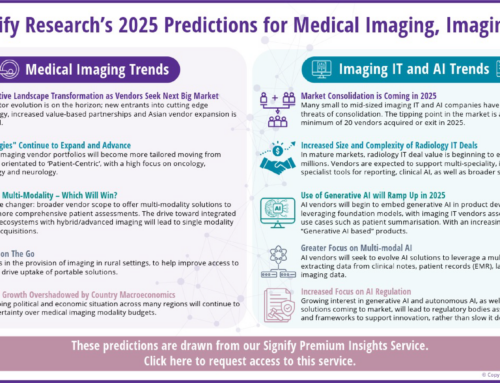Written by Alan Stoddart
The global COVID-19 pandemic may have prevented the world’s radiologists, vendors and purchasers meeting in person, but fortunately the virtual incarnation of RSNA was able to continue on in the spirit of the show.
Prior to the event, several of Signify Research’s analysts explained what they expected to see at the virtual show. Now, having seen the product launches and met with vendors, these analysts revisit their predictions and evaluate the show’s key trends.
AI in Medical Imaging – Co-authored by Dr Sanjay Parekh and Simon Harris
From an AI perspective, it was apparent that the virtual presence of the independent software vendors felt subdued compared to RSNA 2019. Most of the specialist AI vendors we spoke to reported reduced footfall at their virtual booths and a lower level of engagement overall. After an already challenging year, the reduced commercial activity at this year’s RSNA was another blow to the many start-ups trying to penetrate the market. However, AI was once again one of the key themes at the technical exhibition, with many of the modality and informatics vendors showcasing AI solutions, in addition to the plethora of start-ups in the AI Showcase.
Evolution of AI Platforms
Imaging informatics vendors have been central to the evolution of the medical imaging AI market, both in terms of forging partnerships with third-party AI developers as well as pursuing native algorithm developments and AI platforms to support the integration of AI into radiology workflows. In line with our pre-show predictions, several imaging informatics vendors actively promoted their AI platforms, whether existing or new, at this year’s RSNA.
Imaging informatics vendors are generally taking one of two approaches to deliver AI results to the end-user. Some vendors, including Agfa Healthcare and Canon Medical, have focused on direct integrations of a few select AI-based clinical applications, with the results tightly integrated in a common viewer and worklist. Others have developed dedicated AI platforms and AI marketplaces to support users with selecting, purchasing, deploying, integrating, and orchestrating multiple AI solutions within the workflow. GE Healthcare, Philips, and Siemens Healthineers have followed this approach, previously releasing dedicated AI platforms and AI marketplaces. At RSNA 2020, Sectra became the latest vendor to adopt this approach, releasing Amplifier Marketplace. Despite the name, it delivers a three-pronged strategy to integrate AI into its enterprise imaging solution; Amplifier Store to select and purchase third-party solutions, Amplifier Platform to support deployment and orchestration, and Amplifier Analytics, which provides customers with efficiency and quality metrics to ensure AI solutions are continually meeting their needs.
Evolutions of Algorithms
One of the underlying trends over the last year or so has been the evolution of single-purpose algorithms to more comprehensive solutions which combine several algorithms along with tools for specific workflow tasks or exam types. That said, single-purpose tools currently dominate the medical imaging AI market and there is a fast-expanding range of regulatory cleared AI-based clinical applications from an increasingly long list of vendors. There are now more than 100 FDA cleared algorithms on the market that span a range of clinical use-cases.
On the one hand, this influx of narrow point-solutions has expanded the range of clinical use-cases that AI can address and is providing radiologists with a greater choice of AI-based tools. However, the process of selecting, purchasing, deploying and integrating multiple tools from a variety of vendors is becoming increasingly challenging. Some vendors have addressed this challenge by developing comprehensive AI solutions that detect, quantify and classify a variety of radiological findings. Not only are these solutions more cost-effective and easier to integrate into existing workflows, they also more closely mimic how radiologists work and hence provide a higher level of diagnostic support.
Most of the comprehensive AI solutions on the market today are for chest X-ray, but we expect to see this trend become more widespread and be applied to other exam types and modalities. The capabilities of existing comprehensive solutions will also continue to expand, both in terms of accuracy and detection of even more findings. For example, this year we have seen several vendors, including some new market entrants, release algorithms to detect COVID-19 related pneumonia. These task-specific algorithms are expected to become part of comprehensive chest X-ray and chest CT solutions, rather than sold as stand-alone applications. In fact, several AI start-ups already include COVID-19 algorithms as part of their pulmonology solutions, for example, Infervision, Lunit, Qure.ai and RADLogics.
Additionally, imaging informatics vendors are partnering with AI developers to incorporate their AI applications into curated workflow packages. For example, Agfa HealthCare announced RUBEE for AI at RSNA 2020, which forms part of its enterprise imaging offering. RUBEE for AI includes curated workflow packages for specific use cases, incorporating third-party AI solutions, native advanced visualization and workflow orchestration capabilities, smart-hanging protocols, and smart reporting features. Initially, the company announced three packages for breast (using ScreenPoint Medical’s Transpara solution), CT lung (using Riverain Technologies’ CT applications), and chest X-ray with additional packages planned. Canon Medical showcased its Automation Platform, with the first of its curated packages, AutoStroke Solution (using Avicenna.ai’s ICH and LVO detection algorithms). TeraRecon has leveraged its expertise in advanced visualization and partnerships with AI developers through its Eureka Clinical AI Platform Partner Exchange to continue to develop curated workflow packages, the first of which were announced at last year’s RSNA.
Medical Imaging AI for Population Health
One of the newer trends emerging from RSNA 2020 was the use of medical imaging AI beyond the radiology department, for example in population health initiatives. For example, Zebra Medical Vision’s Bone Health solution screens for vertebral compression fractures (VCF), enabling clinicians to identify patients at risk of osteoporosis. Earlier detection and risk-stratification of VCF allows clinicians to implement both primary therapeutic and secondary preventative interventions, potentially reducing the overall cost to the healthcare system. In another example, Automated Real-time Intelligent Assistant (ARIA) from Medo.ai is an AI application for detecting pediatric hip dysplasia on ultrasound exams. Early detection can help to prevent complications in later life, such as osteoarthritis, and potentially avoid the need for hip replacement surgery. In the short-term, we expect the main AI focus for most healthcare providers to be on tools that enhance radiologist productivity and efficiency, such as triage of emergency cases and automation of routine tasks. Longer-term, we expect a greater focus on AI applications that deliver clinical value beyond the radiology department, such as risk stratification to support population health management.
Imaging Informatics & Cloud Technology – Co-authored by Steve Holloway
Broadly speaking, our pre–show predictions were accurate, with different “flavours” of enterprise imaging (EI) and AI adoption at the front and centre of most vendors’ offerings. As expected, operational workflow modules were a substantial part of the relatively few new products launched at the show. These focused both on modality fleet optimisation, such as the Philips ROCC (see the Premium Insight here) which builds collaboration tools for radiologists into core diagnostic platforms, and integration with other major IT systems, such as the EMR, to provide radiologists with a more complete patient dataset within the diagnostic user interface.
Overall, many vendors added new tools or modules to their EI portfolios, but few made substantial platform releases. One exception was Siemens Healthineers, which announced the new Syngo Carbon integration platform base that will become the foundation of its broader integration and platform strategy moving forward (see full Premium Insight here). Point of care imaging was prominent in releases, with a number of Point of Care Ultrasound and non-DICOM imaging integration modules added to platforms to enable health providers to ensure that imaging from across the hospital is centrally captured, stored and accessed via the EI platform. While clinically valuable, these additional tools also help healthcare providers financially, capturing missed billing opportunities.
As expected, Cloud adoption was another key theme of the show, but was perhaps even more pronounced than anticipated; almost all leading imaging IT vendors were showcasing or announcing a hybrid or public cloud partnership. For the most part, however, these were only for one or two components of their overall EI offering – most frequently the clinical/universal viewer and data management platform. This usually entails “cloud-enabling” parts of their offering, though vendors also admitted via our discussions that transitioning their whole portfolios to “cloud native”, thereby leverage the full benefits cloud deployment can offer, would take several years.
It was also encouraging to see more pronounced focus on vendor neutral archives (VNA) and broader data management capability of enterprise imaging solutions. Vendors are increasingly realising that robust competency in data management is the basis for supporting a broader, modular EI strategy. This has been intensified recently with the growing focus on AI integration. Focus on data management was also prominent for research, a slight surprise given the normal diagnostic focus of the show, though reflective also of academic healthcare providers increasingly looking to self-develop their own AI solutions, and the expected use of AI-based image analysis tools in partnership with the preclinical, pharmaceutical and life-sciences sector.
The other main surprise against our predictions was the relative lack of new releases or discussion around structured reporting in radiology, despite the clear directional shift towards more integrated AI from a number of new product releases announced (see AI section). Convergence between advanced visualisation, core diagnostic viewing, clinical viewers and worklists is clearly continuing, yet it seems demand for structured reporting adoption in day-to-day use still has some way to go. This may in part be due to structured reporting having various local care setting nuances, workflow complexities and limited impact of AI on day-to-day reporting so far, limiting vendors from investing substantial R&D in new products. The expected long-term inevitability for structured reporting adoption, with growing AI use and need for improved “data liquidity” within health systems, is therefore not yet strong enough to drive a broader shift towards new reporting products.
X-ray – Co-authored by Bhvita Jani
As anticipated, the COVID-19 pandemic enabled leading X-ray vendors to showcase their latest innovations in lung imaging at RSNA 2020.
At RSNA 2019, lung imaging on mobile DR solutions was centred around addressing detection of pneumothorax. At RSNA 2020 vendors demonstrated how these solutions had been expanded in clinical use to aid detection of pneumonia in COVID-19 patients.
Predictably, the pandemic has accelerated innovation and increased focus on AI lung imaging solutions. For instance, Siemens Healthineers showed its new cloud-based AI Rad Companion Chest X-ray software, which offers decision support for radiographic thorax images, while GE Healthcare also presented its CE marked Thoracic Care Suite; a collection of eight artificial intelligence algorithms designed to detect abnormalities on chest x-rays including signs of pneumonia that could indicate COVID-19. Carestream Health also showed COVID-19 innovation from a hardware perspective and presented the first mobile X-ray system with a collapsible column, the DRX-Revolution, designed to limit the spread of infection by providing critical bedside imaging.
In the image guided therapy market more developments were seen in the mobile C-arm market than the fixed C-arm market compared to previous years. Fujifilm entered the surgical X-ray market for the first time at RSNA, debuting its Persona C Surgical C-Arm after launching earlier this year. GE Healthcare’s GE OEC 3D also made headlines, with the 3D C-arm market only having two contenders previously: Siemens Healthineers and Ziehm Imaging.
The fluoroscopy market, which had become relatively stable in terms of product mix, surprisingly saw two product launches for multipurpose R&F systems: Fujifilm’s Persona RF PREMIUM and Siemens Healthineers’ LUMINOS Lotus Max. Demand for standalone non-multipurpose fluoroscopy systems is declining globally due to their restricted clinical usage, and lack of financial and logistical return on investment. With healthcare investments being stretched globally, multi-modality solutions, which enable higher usage statistics with increased clinical diversity, alongside improved return on investment and enhanced workflow capabilities are becoming more popular.
As expected, workflow enhancement was a key theme, with innovation demonstrated by the implementation of AI within patient positioning. Such developments improve accuracy and ensure that patient anatomy is correctly aligned with the X-ray detector, reducing the need for rescans and retakes. Use of 3D cameras and camera-based workflow functionalities to help speed up imaging protocols were also showcased.
Ultrasound – Co-authored by Mustafa Hassan
As predicted in our pre-RSNA insight, this year’s conference was quiet in terms of new product introductions. There were a few new releases of compact systems for the POC market, with the Sonimage HS2 from Konica Minolta launched at RSNA, while recent releases from Mindray (ME8) and Fujifilm SonoSite (Sonosite PX), were also showcased. There was also a new handheld product, the Vscan Air, teased by GE for release soon.
In the absence of new premium products, vendors instead showcased enhancements to their existing product lines. GE introduced the LOGIQ E10s, Canon debuted the ultrawide view feature for the Aplio i-series and a-series, and Samsung showed off the tissue attenuation imaging (TAI) and tissue scatter distribution imaging (TSI) features on its RS85 prestige. We had expected a greater focus on teleultrasound, but no new solutions were featured at the show. That said, the Philips Collaboration Live platform did have a prominent place in the firm’s virtual booth.
As predicted, AI was a key feature at RSNA 2020, both from ultrasound OEMs and independent software vendors. As well as existing auto measure solutions being showcased, new image acquisition and analysis solutions, such as the AI-based view recognition for GE’s Vivid E95 Ultra Edition (with AI from Intelligent Ultrasound), and LVivo RV and LVivo Bladder from DiA Imaging Analysis, were also shown.
We also predicted that there would be more AI solutions in new clinical areas such as the hip, thyroid and lung. Whilst this was true to an extent, with the new MEDO Hip from Medo.ai and Augmented Vascular Analysis (AVA) from See-Mode Technologies for the automated analysis and reporting of vascular ultrasound scans, it was not to the scale we expected. Somewhat surprisingly, there were no new developments for lung ultrasound AI. Overall, RSNA 2020 saw relatively few AI developments for radiology ultrasound, with vendors seemingly prioritising their AI efforts on the women’s health and cardiology markets.
There were also several solutions showcased to assist in liver analysis, such as the ultrasound-guided attenuation parameter (UGAP) from GE, which quantifies liver steatosis and the EzHRI from Samsung, which assists in diagnosing fatty livers. The aforementioned ultrawide feature from Canon improves visualisation to support the assessment of large organs like the liver, as well as a new feature to automatically report the ‘rule of four’ for interpretation of liver stiffness values, as recommended by the Society of Radiologists in Ultrasound (SRU). We expect that liver ultrasound will continue to be a key focus area for vendors in 2021.
Signify Premium Insights
Signify Research will be launching a new subscription service “Signify Premium Insights” in December. This insight, and similar future insights, will be behind a paywall from then, and you will have to subscribe to “Signify Premium Insights” to view this content from that time. Please click here for more information on how to subscribe to this service.












